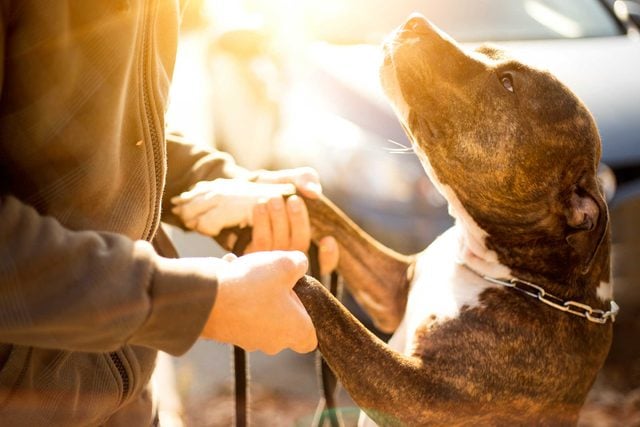The Most Important Factor in Choosing a Dog (Hint: It’s Not Breed)
Updated: Nov. 07, 2022
A dog’s energy level is the single most important factor to consider when choosing a dog, says celebrity dog trainer and YouTube star Zak George. Here’s how to evaluate a low-energy dog, a medium-energy dog, and a high-energy dog.

Figuring out a dog’s energy level is the easiest way to categorize whether or not a dog is right for you. Of course, there are other factors you might think about such as size, puppy versus an adult, and a mixed breed versus a purebred. However, energy is certainly the most important one. For example, once an older couple came into one of my training classes with a toy breed dog who was off the charts with energy. I would rather have seen these people with a low-energy dog (even a mellow Border Collie!) than the little guy they came in with. It’s not that the breed was wrong for them, but the dog’s energy certainly was.
So, how do you choose a dog based on energy level? We’ll outline the different levels so you can figure out where a dog fits. However, keep in mind that when first meeting many dogs, their energy is likely to be very high due to the excitement of greeting someone new. Make sure you ask the breeder or shelter worker what the energy level of the prospective dog is like during his down time. Also, try to visit the dog multiple times to get a more complete sense of what his personality is like.
Low-Energy Dogs: Level One
Because these dogs lie around most of the time, they make a great companion for a relatively inactive person. These couch potatoes require a few short daily walks, and then they’re happy snuggling next to you for the rest of the day. Low-energy dogs are not typically motivated to learn very advanced tasks, nor are they likely to be impressive athletes. However, they’ll likely make up for it in good behavior, and you won’t have to put in as much effort to train them as you would need to for a higher-energy dog.
How to spot a low-energy dog: Untrained low-energy dogs may wag their tails and come up to you, but they’re usually not the type to incessantly jump. Look for the dog who interacts with people and other dogs but does not engage in sustained, vigorous play. When considering a dog who seems to be low energy, first make sure that you rule out sickness or a recent change in the dog’s environment as the cause of his calmness. That way when you get home you won’t be in for any surprises, like finding out that the dog is actually a little Energizer bunny!
Medium-Energy Dogs: Level Two
These dogs are mellow most of the time, but they will have bursts of energy. They are great for the person who wants a hands-on role in training and teaching; medium-energy dogs are good at almost everything, though they may not be perfect at anything. If you want a dog to go running with or to play with at the park, but you’re not looking for exceptional physical talent, then one of these may be your best choice. Most people will do very well with a medium-energy dog.
How to spot a medium-energy dog: When you first meet an untrained level two dog, you are likely to encounter some jumping. Don’t be turned off by this, as a dog who jumps or seems a bit pushy is simply a dog who wants to interact with you. Medium-energy dogs typically enjoy socializing and playing casual or even sustained games of chase with other dogs. They may also have occasional periods of barking or racing around the house, but they’ll calm down fairly naturally after five to 10 minutes without a ton of encouragement from you. Before you take home any pet, it’s important to know what it eats. Find out if cats can eat dog food.
High-Energy Dogs: Level Three
Without regular exercise, high-energy dogs are always raring to go; they can play all day and night. Generally speaking, the more energy a dog has, the more teachable he is. You’d be shocked by what some level three dogs can learn: riding bikes, walking on their front paws, and leaping off docks without fear, to name a few. However, you’ve got to dedicate a lot of time to making sure these dogs get plenty of mental and physical exercise—if you don’t, all that pent-up energy can lead to destructive behaviors, and training can become very challenging. High-energy dogs are typically best for a person who has the time and motivation to commit to some serious training.
How to spot a high-energy dog: Look for the dog who runs up to you and jumps like crazy or insists that you play tug-of-war or fetch by constantly bringing you a toy. These dogs usually have a tail that wags at a hundred miles an hour. They may stare at you enthusiastically as though they’re saying, “Let’s play!” They seem to never tire and will engage with you as long as you’re willing. Put a lot of thought into whether or not a level three dog is right for you, as they are generally the highest maintenance of all dogs.

More Ways to Choose and Raise the Perfect Dog for You
The new book Zak George’s Dog Training Revolution is a groundbreaking, comprehensive guide that teaches people everything they need to know to raise and train their dogs. Learn more and buy the book here. Also, visit Zak George’s website at dogtrainingrevolution.com.